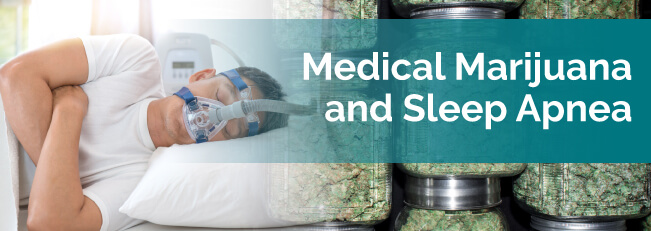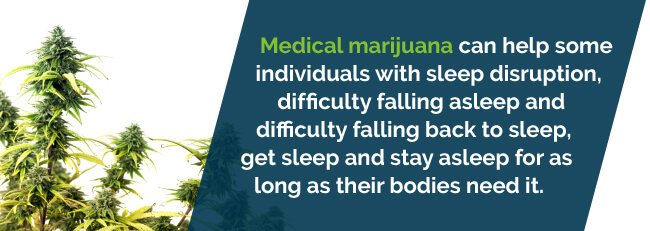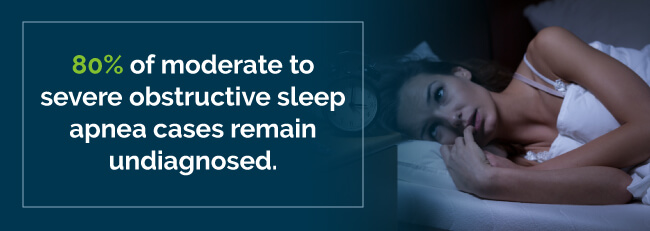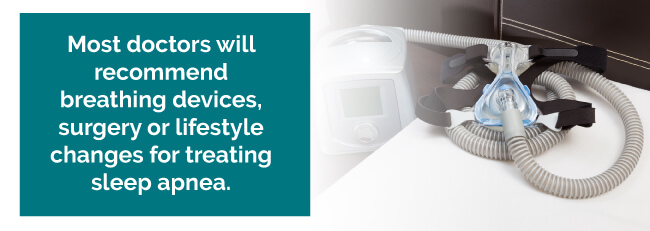
Sleep apnea can wear you or your loved one out in no time. The breathing disruptions from the condition lower the quality of your sleep, making it hard for you and the 22 million other people in the U.S. with sleep apnea to get through the day and stay awake. Let’s learn more about cannabis and sleep apnea to help you determine if medical marijuana is the right treatment.
A 2002 study on rats with sleep apnea showed that delta 9 THC and oleamide, both types of medical marijuana, promoted normal breathing during sleep in the 11 rats used for the study.
The study was based on observations that serotonin worsens sleep apnea and that medical marijuana can limit the effect of serotonin on cells in the inferior ganglion of the vagus nerve, which plays a role in breathing sensations. Both of the drugs displayed the anticipated effect during every stage of sleep. That means that relief was found from serotonin induced breathing disorders the entire time the rats were sleeping.
Dr. David Carley, the study’s lead author, worked off that data to conduct the first THC and sleep apnea study on human subjects. He tested the effects of different doses of THC on 17 sleep apnea patients and discovered that they experienced an average symptom reduction of 32 percent. Of course, since the study only examined 17 patients, further clinical trials are needed to get conclusive evidence.
Nonetheless, these studies have tons of promise for patients looking for natural relief for their sleep apnea. They both suggest that higher doses of THC could result in greater effects. So, dosing a patient with the highest amount they can tolerate could provide the maximum amount of benefits for a restful night’s sleep.
Unfortunately, research on sleep apnea and medical marijuana is mostly in preclinical stages. However, physicians tend to have more access to experimental medication literature than the general public. Therefore, a sleep apnea patient’s doctor is the best person to determine whether medical marijuana is adequate sleep apnea treatment for that particular patient.
Medical marijuana research does support using it as a treatment for other aspects of sleep apnea apart from breathing disruption. It is important to remember that breathing disruption is an important symptom to treat. If the marijuana is not stopping the disruption, it may have to be used in conjunction with another treatment that prevents the sleep interruption.
Find A Doctor Find A Dispensary

Often, an airway obstruction causes sleep apnea. The airway may temporarily collapse while sleeping. Alternatively, there may be something such as enlarged tonsils blocking the airway. In these cases, the obstruction is the problem. Treatment with medical marijuana may not be able to stabilize breathing without lifestyle changes or medical treatment for the blockage.
Overweight individuals are most likely to have this problem. Losing weight may help with the sleep apnea, though it can be a combination of obstructed airways and the issues mentioned earlier with serotonin causing abnormal breathing patterns. In these cases, weight loss can help the former while medical marijuana can help the latter, leading to sleep that is more restful.

As mentioned above, sleep apnea can have a mild to severe impact on quality of sleep. Medical marijuana can help some individuals with sleep disruption, difficulty falling asleep and difficulty falling back to sleep, get sleep and stay asleep for as long as their bodies need it. In this way, medical marijuana can improve the quality of life for sleep apnea sufferers.
Those who respond well are likely to find that they are suffering less fatigue during the day because their sleep quality has improved. Because medical marijuana has these added benefits, it’s usable for all three types of sleep apnea — that caused by obstruction, that caused by brain function and that caused by both.
Daytime fatigue is one of the most common sleep apnea symptoms. While we often associate medical cannabis with sleepiness and relaxation, some marijuana strains can energize patients dealing with chronic fatigue. A patient can use an energizing medical weed strain to relieve any lingering sleepiness they feel during traditional treatment.
Other medical marijuana strains can relax the user and help them sleep deeper. In the situation that the patient needs an alternative to sleeping pills, they can use medical weed instead. While sleeping pills often stop working, medical marijuana is reliable in delivering its effects.
When a sleep apnea patient deals with mood problems caused by sleep apnea, they can use uplifting strains to improve their mood and reduce depression and irritation. Medical marijuana serves as a potent antidepressant and calms you down, which can make a difference in your day-to-day life if you experience anxiety or depression.
With the knowledge we have about medical cannabis and sleep apnea, we can safely say that medical marijuana serves as an excellent supplement to typical sleep apnea treatment. While we’re still learning about the direct effects of cannabinoids on sleep apnea, we can use medical weed to reduce symptoms and address underlying causes of the condition.
The ideal strain for your sleep apnea depends on what symptoms you want to treat, your body’s chemistry and your preferences. Medical marijuana is a versatile medicine — you can choose a strain that helps with your exact symptoms. Selecting the right strain involves experimentation and help from the experts, like your medical cannabis doctor or budtender.
Understanding how medical marijuana strains are categorized can make the decision-making process easier for you. Indica, sativa and hybrid strains each have unique benefits and properties.
If you want to use medical pot to address your sleep apnea directly, like in the earlier studies, you should look for a strain featuring a good mix of THC and CBD with a focus on THC. THC is the chemical that researchers think could treat sleep apnea, but it can cause psychoactive effects like a “high.” CBD balances out the negative effects of THC, so strains featuring CBD can prevent the severity of these effects.
Some strains you can try to reduce your sleep apnea index include:
One to One offers an exact balance of THC and CBD while Crimea Blue and Super Sour Diesel have high amounts of CBD for dominant sativa strains.
Many strains that relieve fatigue also have mood-boosting properties, so you can easily use weed to address both issues at once. Popular uplifting strains include:
You’ll find a large selection of strains are available with more in development as medical marijuana becomes legalized across the U.S.
Customizing your medical weed treatment plan continues after you choose a strain. Now, you must decide how to consume it. Fortunately, you have tons of options, most of which work well for sleep apnea:
Because you must consider several different factors when deciding how you’ll administer your medical weed, like your state’s laws and health concerns, you’ll need to communicate with your medical marijuana doctor about your options so you can make an informed decision.
Just like traditional medicine, medical marijuana has potential side effects in addition to its possible benefits. But, these side effects tend to be milder than those that come with many traditional medications. Some marijuana side effects, however, can act as a treatment for patients with a health issue, like a reduced appetite or increased saliva.
Possible side effects of medical cannabis include:
Many medical cannabis physicians recommend tracking your side effects. Keep a journal and update your doctor on what you’re experiencing. They’ll often suggest trying a new strain, adjusting your dosage or another tactic to improve your experience.
If you think that medical marijuana could be a good medication option for you or someone you know with sleep apnea, it’s easy to get started when you have the necessary information. Here at MarijuanaDoctors.com, we aim to give you the knowledge you need to make an informed medical decision.
The first step to starting cannabis medication is learning about your state laws and what they require you to do to become eligible for medical marijuana use. Second, you will need to find a licensed medical marijuana doctor. Third, you’ll need to choose a local dispensary for purchasing your medical marijuana for your sleep apnea.
At MarijuanaDoctors.com, we provide a database with a convenient, easy-to-use search engine for finding licensed doctors and dispensaries. Start your medical marijuana journey today by browsing for a compassionate medical marijuana physician and dispensary near you.
Find A Doctor Find A Dispensary
Sleep apnea is a sleeping disorder where you experience regular interruptions in breathing while sleeping, hence its name as apnea translates to “without breath” in Greek. You can experience as many as 30 disruptions in just one hour. These stoppages jolt you out of your deep sleep, reducing the amount of quality sleep you get.
Sleep apnea can reduce your late, non-REM and REM sleep stages. REM cycles repair and heal your body, as well as help you feel refreshed in the morning. That’s why many patients with sleep apnea struggle to stay awake during the day or feel fatigued.
Doctors often don’t detect sleep apnea because it only happens when you’re asleep. You can’t find it during an office visit or with a blood test. Many times, even the patient doesn’t know they have it — in fact, 80 percent of moderate to severe obstructive sleep apnea cases remain undiagnosed.

To diagnose sleep apnea, a doctor can use a variety of approaches. Sometimes, they’ll ask you to monitor your sleep quality and habits to see if they have a pattern. In other cases, they’ll conduct a physical exam or sleep study.
Some patients can have both obstructive and central sleep apnea. This form of the disorder requires a multifaceted approach for successful treatment.
Certain people are more susceptible to sleep apnea than others. Men have a higher risk of having sleep apnea than women, and your risk gets higher as you age. Children and infants can also develop the condition, with one to four percent of children experiencing sleep apnea. Family history and health issues, like diabetes and heart problems, can increase your risks of sleep apnea.
In addition to interrupted breathing during sleep, sleep apnea patients can experience symptoms like:
If you make frequent trips to the bathroom at night, consider talking to your doctor about sleep apnea. A recent study discovered that more than 84 percent of patients with sleep apnea make nighttime trips to the bathroom.
Knowing the symptoms of sleep apnea is the first step to treating the condition, which is crucial as it can increase your risk of a stroke.
Most doctors will recommend breathing devices, surgery or lifestyle changes for treating sleep apnea. If an underlying condition causes your apnea, your doctor will also try to address its symptoms.
The most common treatment for sleep apnea is a continuous positive airway pressure (CPAP) machine. To use a CPAP machine, you fit a mask over your mouth that you wear while you sleep. It blows air into your throat, which puts pressure on your airway to keep it open.

A CPAP machine can cause mild to moderate side effects, including:
Some patients may only need to make lifestyle changes to experience relief. Smoking and alcohol increase the severity of sleep apnea symptoms, so quitting those substances can help. They can also change their sleep habits, sleeping on their sides or using a treatment to keep their nasal passages open.
Patients experiencing mild sleep apnea symptoms might use a mouthpiece when they sleep. An orthodontist will make you a custom-fit device, just like they do with braces and retainers. The mouthpiece corrects your jaw and tongue to facilitate open airways.
In certain cases, surgery to remove or shrink excess tissue can clear your respiratory system to make it easier to breathe at night. When your physician just needs to shrink or stiffen your throat tissue, you can get the procedure done right at the doctor’s office. Procedures involving incisions and tissue removal must be done at a hospital and require a longer recovery period.